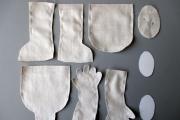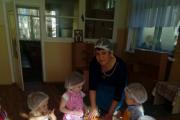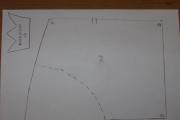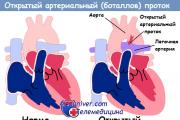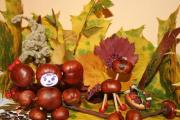What to feed a child a year: menu, recipes. What to feed a one-year-old child: proper and varied nutrition
Perhaps there are no words in the Russian language to express the degree of pride and joy that parents feel when their baby turns one year old. A new stage in the baby’s life begins, his habits, behavior and, of course, the menu change. Today we will talk about correct mode feeding a one-year-old baby and expanding his diet.
Diet changes
The baby continues to eat “bruised” food, but it is no longer a problem for him to cope with small pieces of vegetables or carefully chopped meat. Now it is no longer necessary to cook porridge from ground cereals; your baby can be offered thoroughly boiled oatmeal, rice or buckwheat without prior grinding. Wheat, corn porridge or millet will not be superfluous in the diet.
Most likely, your baby has already grown a decent set of teeth - their number can reach 10 by the age of 1 year. Periodically offer him steamed cutlets - not only from meat, but also from fish, meatballs, stewed vegetables are also good for him. The bread is mostly black, and as a treat you can treat your baby with cookies or crackers. By the age of one, most babies eat four to five times a day.
What to feed a 1 year old baby
There are several rules that should be followed when creating a menu for a one-year-old baby:
- Breakfast - mainly porridge, 2-3 times a week - cottage cheese. As a drink, you can offer tea, preferably herbal, for children, fruit juice or compote.
- Dinner. Snack - a little vegetable salad. It can be boiled carrots or beets, green peas (in summer), broccoli. The first course is soup, meat or vegetable, sometimes borscht, one option is light fish soup. The second course is vegetables with a meat side dish. Dessert - fruit compote, crackers or cookies.
- Afternoon snack. A light dish that provides your child with energy until dinner.
- Dinner is the same as the morning meal.
Don't forget to offer your baby something to drink not only after meals, but also between meals. In order not to kill your appetite before feeding, give your baby plain water. It is especially important to provide for the child sufficient quantity drinking in summer period.
Should I give up breastfeeding?
Of course, by this time most babies find themselves without breast milk. But if your baby has not yet been weaned from the breast, do not rush; if possible, give him the opportunity to suckle before bedtime. It has been proven that those present in mother's milk Antibodies not only help improve immunity, but also prevent the development of staphylococcus - it is its bacteria that subsequently cause caries.
If your baby still eats formula at night, now is the time to get rid of this habit. Residues of milk on the teeth contribute to the formation of an acidic environment, resulting in negative impact on enamel - the likelihood of caries increases. This recommendation in no way applies to breastfeeding.
Calorie nutrition
In the period from 1 year to one and a half years, the baby needs to receive about 1300 kcal daily. The daily volume of food is 1000–1250 ml. Most of the products are for lunch - approximately 1/3, 1/4 each - breakfast and dinner, the rest is an afternoon snack. Experts recommend planning the menu in such a way that proteins and fats of animal origin predominate in the food (70 and 13%, respectively).
An important point is the restriction of meat products due to religious or other considerations. Even if parents adhere to fasting, they should not teach their baby to fast - his body is not yet ready for this and needs a full range of useful substances. They are needed for the development and formation of internal organs.
Fruits and vegetables in a baby's diet
The time has come to expand the list of allowed fruits, supplementing the diet with kiwi crumbs, sea buckthorn, blackberries, and blueberries. And one more surprise for the baby - now he can try citrus fruits little by little. It’s better to start with a tiny portion - to monitor the reaction digestive system on new product. If a child is prone to allergies, it is better to refrain from such experiments.
As before, berries with hard or dense skins must be peeled. Fruits such as kiwi or apricots can be offered to the baby in small slices. You still shouldn’t give your baby grapes, as they promote fermentation processes, and besides, they don’t contain as many vitamins as other fruits and berries.
A child can consume no more than 250 g of fruit per day - including those added to porridge, yogurt or cottage cheese. In addition, the baby should be given juices - up to 100 ml. Now they can be not only filtered, but also with pulp.
Menu for the week
We present to your attention the menu for the week. Use it as a base.
Monday:
- Breakfast. Rice porridge with omelette and cheese. Fruit puree. Dried fruit compote.
- Dinner. Spinach salad. Pumpkin puree soup. Vegetable puree with meatballs. A piece of rye bread. Apple-carrot juice.
- Afternoon snack. Curd pudding with cookies. Cherry jelly.
- Dinner. Mashed potatoes with liver pate. Warm milk. Rusk.
- Before bed - a portion of breast milk or kefir (every evening).
- Breakfast. Oatmeal with prunes. Tea with milk. Bread with a thin layer of butter.
- Dinner. Boiled carrot salad. Borscht with chicken fillet, seasoned with sour cream. Meat pudding with vegetables (cauliflower, broccoli, carrots and potatoes). Rye bread. Fresh fruit compote.
- Afternoon snack. Yogurt with fruit filling. Cookie. Apricot juice.
- Dinner. Pasta casserole. Rabbit soufflé. Tea with cookies.
- Breakfast. Corn porridge on milk. Tea and a sandwich with grated cheese.
- Dinner. Pumpkin salad with apple. Soup with veal meatballs and vegetables. Rice with fish cutlet. Peach juice. Bread.
- Afternoon snack. Baked apple with cottage cheese (you can add cinnamon). Warm milk with cookies.
- Dinner. Mashed potatoes with cutlet. Tea with crackers.
- Breakfast. Wheat porridge with milk and wild berries. Bread and butter and herbal tea.
- Dinner. Salad from Chinese cabbage with the addition of apple and lemon juice. Broccoli soup with meatballs. Vegetable puree with meat pudding. Fruit compote. Bread.
- Afternoon snack. Cottage cheese with fresh fruit. Cookie. Raspberry jelly.
- Dinner. Stuffed cabbage rolls with rice and meat filling (without frying). Vitamin drink made from rose hips. Rusk.
- Breakfast. Boiled carrot salad. Buckwheat porridge with milk. Apple juice. Cookie.
- Dinner. Pumpkin puree soup. Chicken meatballs with rice porridge and gravy. Kefir. Bread.
- Afternoon snack. Yogurt with apricots or peach. Apple and carrot puree. Rusk.
- Dinner. Mashed potatoes with stewed fish. Tea with a sandwich.
- Breakfast. Cottage cheese and apple pudding. Apricot juice with cookies.
- Dinner. Beetroot salad. Rice soup puree with vegetables. Veal cutlets with vegetable puree. Bread.
- Afternoon snack. Omelette. Kefir with cookies.
- Dinner. Buckwheat porridge with liver pate. Tea with crackers.
Sunday:
- Breakfast. Mashed potatoes with stew (mash thoroughly) and gravy. Cabbage salad with carrots. Apple juice with cookies.
- Dinner. Vegetable soup made from broccoli, cauliflower, spinach and carrots. Curd pudding with fruit. Tea with sandwich (grated cheese).
- Afternoon snack. Yogurt with gingerbread. Dried fruit compote.
- Dinner. Pancakes with jam. Tea with cookies.
Porridge. Cook until the grains are completely cooked. This applies to porridges both with milk and water. Season with butter - 2-4 g. It is advisable to mix vegetable purees with a blender so that they turn into a uniform mass. In the summer, be sure to add fresh herbs - parsley, dill, cilantro.
Soups It’s better to cook it daily, if that doesn’t work, once every two days. It is advisable to add the products one by one, taking care that they are not overcooked during the cooking process. Recommended sequence:
- Place the meat first and fill it with water. After boiling, it must be drained, then filled with fresh water and put back on the fire.
- Carrots, celery, parsley root and onion. It does not need to be crushed, since most children do not treat it with much love. Place the whole onion in the pan. This category of products is added 20 minutes after the broth boils again.
- The next batch is potatoes and cereals. They are added approximately half an hour after the start of cooking.
- Add vegetables ten minutes after potatoes and cereals.
- Tomatoes, sauerkraut and the cucumbers should be added at the end of cooking, since if they are added earlier, they slow down the cooking of the potatoes (they do not boil soft).
- Throw in the greens after turning off the heat - they will steep for 5-10 minutes.
This is a universal recipe for preparing all types of soups. By the way, it is recommended to salt them 30 minutes before the end of cooking.
A serving of salad for one year old child - about 25 g. Of course, you will not weigh it every time. Approximately this is 1–1.5 tablespoons. Mostly give your baby boiled vegetables: beets, carrots, pumpkin. Cabbage - mainly in fresh, be sure to squeeze it well so that it releases the juice and becomes soft.
Juices. It is better to give them freshly squeezed. Now that the baby has grown up, you can give him mixes. The most popular option is apple-carrot. You can also mix wild berries, or add some kiwi or other fruits.
Preparation fresh fruit compotes- Do not overcook them under any circumstances, as this will destroy the vitamins. Bring to a boil, turn off, and leave to steep. Give your kids rosehip infusion regularly. By itself it is not very tasty, but in the company of dried fruits the child will like it much more.
The above menu is designed for a healthy baby aged 1 year. If your child suffers from allergies or chronic diseases, consult your pediatrician about nutrition.
Basic menu for a 1-year-old child
The main menu is still milk and dairy products. The baby can still be breastfed and also receive yogurt, sour cream, cottage cheese, cheese, kefir, and cow's milk. It is best if the dairy products are specialized for children; they contain less harmful fats and preservatives.
During the day, the child should eat about 1000-1200 grams. food products. Thus, at breakfast he will eat about 260 grams, at lunch - 360, at midday - 220, at dinner - 360 grams.
Protein food is a must for little ones, so the menu should include meat. It is best to use veal, lean beef and chicken. The meat must be cooked or stewed long enough to be safe and tender. Pates and puree soups are prepared from boiled meat, casseroles, meatballs, and cutlets are made from minced meat. Meat dishes are usually included in the lunch menu.
The most beneficial are buckwheat and oatmeal porridge., but to diversify the table it is best to alternate them with barley, semolina and pearl barley. The porridge is cooked in milk and served to the little gourmet for breakfast. You should definitely put butter in it. There should be little of it; a child can eat about 12 grams during the day. Those lucky enough to have teeth can be offered a sandwich of soft white bread with butter for breakfast.
Sunflower oils– an essential source of vitamins– should also be present in the diet. A little sunflower or corn oil can be added to so-called “salads” for babies, which are pureed vegetables. The daily intake of vegetable oil is approximately one teaspoon.
Salads are best prepared for lunch. They can consist of both fresh and boiled vegetables, herbs, fruits and berries. Unfamiliar nutritional components should be introduced gradually: no more than one per day. This will contribute better work the child’s digestive system and in case of an allergic reaction will narrow the choice of reagent.
Vegetable salads a one-year-old child can cook from boiled potatoes, carrots (raw and boiled), cabbage, boiled beets, zucchini (stewed), pumpkin and tomatoes. You can add boiled egg yolk to them.
Fruit salads , consisting of fruits grated on a fine grater, are prepared from apples, pears, and bananas. In them, as well as in porridge, you can put fresh berries: raspberries, black currants, sea buckthorn, lingonberries and cranberries. Fruits and berries are excellent food for an afternoon snack.
It is advisable to add fish to your child’s diet.. Low-fat varieties are suitable, for example, pollock, cod, and greenling. Boiled fillet with bones carefully removed is chopped and made into cutlets, soufflé or mixed with vegetables. A child is allowed up to 80 grams of fish per week. It, like meat, is best included in the lunch menu.
At this age, the mother has a great chance to teach her baby to eat first courses. Puree soups and pureed borscht for children are prepared in vegetable or recycled meat broth. It's easy to prepare. The broth, in which the meat has been boiled for 10-15 minutes, is drained (it can be used for “adult” dishes), the meat is poured clean water and start cooking again. Soup made with this broth will be lean and safe for child's body.
As a dessert On the child's table there may be fruit pastilles, marmalade, dry cookies, biscuits.
A healthy, strong baby is the best reward for a mother. By organizing proper nutrition for him, parents make a big contribution to his health.
Menu option for a 1 year old child
Breakfast
Pearl barley porridge (buckwheat, semolina, oatmeal) 150 gr.
Tea 100 ml.
Wheat bread 10 gr.
Butter 5 gr.
Dinner
Vegetable puree soup 100 ml.
Chicken pate with herbs 50 gr.
Mashed potatoes 100 gr.
Fruit juice 100 ml.
Wheat bread 10 gr.
Afternoon snack
Kefir (milk, yogurt) 100 ml.
Cookies 15 gr.
Banana 100 gr.
Dinner
Curd casserole 150 gr.
Omelet 100 gr.
Milk (kefir, yogurt) 100 ml.
Wheat bread 10 gr.
What to feed a one-year-old baby?
The menu for a 1-year-old child has varied significantly. Now it is not only milk and various mixtures, but also other products.
Let's take a closer look at the menu for a 1-year-old child.
Breakfasts.
For breakfast, you can offer your baby porridge and half egg yolk. Fruit puree or fruits, they can be added to porridge.
What kind of cereals can a one-year-old child eat?
These can be gluten-free porridges (corn, buckwheat, rice), as well as gluten-containing porridges (wheat, oatmeal, semolina).
The volume of porridge should be approximately 150-200 ml. Add 5g butter to the porridge.
Drinks
Tea, fruit infusion, juice.
Another breakfast option.
Steamed omelette. For the omelette, a piece of bread spread with butter or cheese. A baby from one to one and a half years old can receive up to 15-20 g of oil per day. For a child of this age, it is better to choose white bread, it is easier to digest (up to 40g per day)
Drinks
Kissel or compote.
Lunches.
You can start your lunch with a vegetable salad. For example, cucumbers or tomatoes, or carrots, grated and seasoned with vegetable oil (5-7g) or sour cream (5-10g).
Soups.
Milk with vermicelli. Remember: it is not recommended to give pasta to your baby often, about once a week and in small quantities (30-35g).
Vegetable (from cauliflower, cabbage soup, borscht, etc., including pureed soups).
On to the second.
Vegetable puree. By the age of one year, you can already add vegetables such as beets, turnips, green peas, radishes, and beans.
Meat dish. Remember that the meat should be cooked separately. Meat puree, meatballs or soufflé. Do not overuse potatoes, they have a high starch content.
Once or twice a week, instead of meat, you can give your baby river or sea fish. Definitely not fatty varieties.
Drinks
Compote or jelly, you can have fruit tea or juice.
Afternoons.
For an afternoon snack, you can prepare soufflés, cottage cheese with sour cream from the usual cottage cheese and kefir; at about 1.5 years old, you can give pancakes with cottage cheese, if the child has enough teething. Of course not often, once a week. In addition, give fruit puree, maybe low-fat cookies, not every day.
Drinks
Juice, or fruit tea.
Dinners.
For dinner, you can offer a vegetable-cereal or vegetable-meat dish. For example: zucchini soufflé with meat puree, oatmeal porridge with pumpkin, stewed beets with apples, vegetable stew with meat puree. Plus fruit puree or juice. A child is offered no more than 100g of fruit puree and no more than 100ml of juice per day.
Before bed.
If you continue to breastfeed your baby, then in this case, breast milk. Or a fermented milk drink (baby kefir).
At this age, the baby’s diet should not include: cakes, pastries, chocolates, no matter how much you would like to pamper your little one. This does not mean that you can pamper your child; choose from sweets: marshmallows, jams, marmalade, preserves (if they contain fructose).
It's important to remember.
There is a basic rule: a child from one to one and a half years old should have four or five meals a day, with intervals between feedings of 4 hours. Observe enough strict regime nutrition, the baby must develop a conditioned reflex. The volume of food should be 1000 - 1200 ml, not counting liquid, per day. These recommendations should be followed for up to one and a half years.
Mommies, follow the rules for introducing new products, monitor the cleanliness and freshness of the products. Also, keep your hands and your baby’s hands clean, as well as your child’s dishes, to avoid intestinal infections.
After a year
Unfortunately, many mothers stop being responsible about their baby’s nutrition as soon as she turns one year old. At one year old, the child is traditionally transferred to the common table. But in vain. Nutrition must remain specialized.
Gradual development chewing apparatus requires the introduction of solid food of varying degrees of grinding into the diet of a child over 1 year of age. Still big role belongs milk and dairy products, which should be included in the child’s daily diet (milk in any form up to 500-600 ml, cottage cheese on average 50 g, cream or sour cream 5 g). Cottage cheese, cream, sour cream can be given after 1-2 days, but in appropriate quantities.
From meat products children over a year old Along with beef, chicken, chicken, rabbit, lean pork and lamb, and various offal are recommended. The number of fish increases. On average, a child from 1 to 3 years old needs 85 g of meat and 25 g of fish per day. During the week, he can receive meat (100-120 g each) for 4-5 days and fish (70-100 g each) for 2-3 days.
A child over one year old can be given whole egg(every other day, or half daily), and not just the yolk. However, this must be done with caution, as chicken egg white can cause an allergic reaction in some children. In such cases, the protein should be abandoned and only the yolk should be given for some time.
From fatty foods We recommend giving 12-17 g of butter (for a sandwich, in ready-made dishes) and up to 8-10 g of vegetable oil (for dressing salads, vinaigrettes, various vegetable dishes), but not margarine and refractory edible fats (beef, lamb).
Among the cereals The most useful are oatmeal and buckwheat; barley, pearl barley, and wheat are allowed. You can also use specially enriched cereals. Pasta (noodles, vermicelli) is given infrequently, as they are poor in vitamins and contain excess carbohydrates. Legumes (peas, beans, soybeans) are given in limited quantities to children over 1.5 years old in the form of pureed soups. On average, a child needs 15-20 g of cereal, 5 g of pasta, about 100 g of bread (including 30-40 g of rye) per day. Bakery products (crackers, bagels, buns) are also suitable with a corresponding reduction in the amount of bread.
The main source of carbohydrates in the diet of a child older than one year is sugar, however, its quantity should be strictly limited. An “overdose” of sugar can lead to metabolic disorders, excess body weight, and sometimes worsening appetite. A child under 3 years old needs from 35 to 50 g of sugar per day. Pastille, marmalade, fruit caramel, preserves, marmalade, and honey are allowed for confectionery products (if well tolerated).
The total amount of confectionery products should not exceed 10-15 g per day. Vegetables, fruits and berries are widely used in baby food as the main source of minerals and vitamins.
Vegetables you can give a wide variety, including radishes, radishes, green onions, garlic, as well as leafy greens (dill, parsley, sorrel, spinach, lettuce, nettle). A child needs about 120-150 g of potatoes and up to 200 g of other vegetables per day. The daily diet should include fresh fruits, berries (up to 200 g) and juices (100-150 ml).
Until the age of 1.5 years, a child is usually fed 5 times a day, although some children already at this age refuse the last (night) feeding and switch to 4 meals a day: breakfast, lunch, afternoon snack and dinner.
Between feedings, the child should not be given any food, especially sweets, as this leads to disruption of normal digestion and loss of appetite. The same applies to fruit juices, which are sometimes offered to a child instead of drinking. In this case, it is better to use fruit drinks, compotes, and unsweetened herbal infusions.
Make sure your child receives the appropriate amount of food for his age. So, for a child aged 1 to 1.5 years, it should average 1000-1200 ml, from 1.5 to 3 years - 1400-1500 ml (juices, decoctions and other drinks are not included in this volume).
Reducing the amount of food can lead to malnutrition, and exceeding it can lead to decreased appetite. It is especially irrational to increase the volume of the first course, which parents often do if the child willingly eats soup or broth. However, having eaten a lot of soup, the child can no longer cope with the second course, which, as a rule, is more complete, since it contains meat, vegetables, etc.
Culinary processing of food for young children has its own characteristics, due to the uniqueness of their development. Until the age of 1.5 years, the baby does not yet have sufficient opportunities to absorb roughage, so he is fed purees, thin porridge etc. But at the same time, the child must be taught to eat denser foods. If children long time they receive only semi-liquid and pureed dishes, their chewing skills do not develop well and subsequently they are very sluggish and reluctant to eat meat, raw vegetables and fruits.
Children over 1.5 years old are given boiled (but no longer mashed) porridge, vegetable and cereal casseroles, stewed vegetables cut into small pieces, meat and fish cutlets.
After 2 years, meat can be given in the form of fried cutlets, finely chopped stew, fish - boiled and fried, freed from bones.
Use fresh vegetables as widely as possible in the form of finely chopped salads, and for children under 1.5 years old - grated on a coarse grater. Raw vegetable salads can be given not only for lunch, but also for breakfast and dinner.
To save nutritional value products must strictly follow the rules of their culinary processing.
Milk can be boiled for no more than 2-3 minutes, avoiding repeated boiling. When preparing porridges, vegetable purees, and casseroles, milk is added to already boiled cereals or vegetables.
Meat after careful mechanical cleaning it is better to cook in large pieces, dipping in hot water. At the same time, the proteins coagulate on the surface of the meat and the meat juice does not flow out. Meat and cutlets should be fried in boiling fat, which also promotes the formation of a crust that retains the meat juice. The stew is prepared by lightly frying and then boiling in a small amount of water.
It is very important to process vegetables correctly. When cleaning, cut off as thin a layer as possible; it is in the upper layers that the most more vitamins For vinaigrettes and salads, it is better to boil vegetables in their skins in a small amount of water or steam them. Peeled vegetables should not be left in water for a long time to avoid leaching of vitamins and minerals, but they should be boiled in a small amount of water, then used for food. Cooking time is strictly limited: potatoes, cabbage, carrots are boiled for no more than 25-30 minutes, beets - 1-1.5 hours, sorrel, spinach - up to 10 minutes.
Vegetables and fruits for raw salads are peeled and cut (grated) immediately before eating, since when peeled and crushed foods are exposed to air oxygen, vitamins are destroyed in them, especially ascorbic acid.
The diet and nature of nutrition in the second year of life differ by six months.
It is better to feed children up to one and a half years five times a day. If healthy child refuses the last (fifth) feeding, then he is transferred to a four-time feeding rhythm with an interval of four hours. Whatever the frequency of feeding the baby, the main thing is that it is constantly observed.
The daily amount of food for children from one to one and a half years old should be approximately 1200 g, that is, 240-250 g per meal with five feedings a day.
Using a pacifier at this age is harmful. It subsequently leads to difficulty chewing food and refusal of any food other than liquid food. When receiving pureed foods from a spoon, the baby instinctively makes chewing movements before swallowing it, and thereby prepares to receive dense food lumps.
Dairy products play a major role in a child's nutrition. At this age, he is entitled to 700 ml of milk per day, taking into account the amount that is used for preparing various dishes.
Cottage cheese is an essential component of nutrition and can be included in any meal. You can make pudding out of it and add fruit.
Cheese is given in grated form. It can be used for sandwiches mixed with butter or added to pasta.
Eggs Children are given only chicken: either hard-boiled or added to various dishes. Until the age of one and a half years, it is recommended to give only hard-boiled yolk, adding it to vegetable purees. After one and a half years, you can offer omelettes, as in in kind, and with various additives, mainly vegetables (potatoes, green peas, carrots, cauliflower).
The daily allowance of meat for children under three years of age is 85 g. Lean varieties of meat are used (beef, veal, pork), as well as poultry.
Meat dishesIt is advisable to give them in the first half of the day, since they take longer to digest, and those eaten in the evening overstimulate the nervous system, making it difficult to fall asleep.
Children cook broth for first courses or prepare soufflés, meatballs, or steamed cutlets from minced meat. Liver is very useful for a child; it is better to give it in the form of a pate. It is good to add a mild sauce (toasted flour, diluted with broth and seasoned with cream or sour cream) to meat dishes. A vegetable side dish is better.
Once or twice a week, instead of meat, you should give it to your child.fish, giving preference to fish fillets or varieties without small bones.
But you must remember that river (lake) fish with impaired metabolism (exudative diathesis) can cause an exacerbation of the disease in some children. Cod is the easiest to digest.
For children under one and a half years old, fish is prepared in the form of meatballs or steamed, and must be wiped.
It is advisable to give vegetable oil mostly in its raw form, adding to vegetable puree and grated vegetable dishes.
From animal cheeses, lard (lard) can be given in small quantities 1-2 times a week. Pork (backbone) lard, beef and lamb fats are not recommended because they are difficult to digest.
Vegetable pureesIt is better to prepare combined ones; the composition of the puree can be changed, taking into account the child’s taste characteristics.
It is not recommended to indulge in mashed potatoes due to the large amount of starch that makes digestion difficult. The daily requirement of potatoes is 150 g.
Vegetables used include white cabbage, carrots, beets, zucchini, pumpkin, green peas, cauliflower, turnips, onions.
It is useful and convenient to use special children's canned vegetables. Their only drawback is that, regardless of composition, they cause some monotony. taste sensations. This may lead to the child not wanting to try new types of canned food. Therefore, it is better to alternate dishes homemade with those purchased in the store.
Porridge- a very filling dish baby food. It should not be given more than once a day.Now porridges are given a more modest place in children's nutrition, since a number of cereals (oats, wheat), from which cereals are prepared, contain phytic acid, which impairs the absorption of calcium from food, which disrupts the normal ossification of the skeleton.
For a child of the second year of life, porridge is cooked semi-viscous. Porridges that require a long time of boiling are first boiled in water and then milk is added.
You can combine porridge with vegetables, fruits, and meat. You can make puddings from porridge in the oven.
Thin and small pasta is used, cooked with milk, seasoned with butter and cheese.
It is advisable that the first and last feedings consist of vegetable or fruit purees, various cereals, cottage cheese or egg dishes. It is better to drink them with kefir or milk.
Honey should be given to children very carefully.
DinnerIt’s better to start with a snack in the form of a variety of salads - grated carrots, peeled cucumbers, tomatoes, white cabbage, green salad, pumpkin. It is advisable to add finely chopped dill, parsley, onion, celery to salads - to develop a child’s taste for green vegetables as early as possible.
Approximate one-time amount of food (in grams), recommended for children aged 1 to 1.5 years. Daily food volume - 1200-1250 ml... Calorie content of the daily diet - 1200 kcal
Breakfast: Porridge or vegetable dish (150 g); meat or fish dish, or omelette (50 g); Milk (100 ml)
Dinner: Soup (50 g); meat or fish dish (50 g); side dish (70 g); fruit juice (100 ml)
Afternoon snack: Kefir or milk (150 ml); cookies (15 g); (100 g)
Dinner: Vegetable dish or porridge, or cottage cheese casserole (150 g); milk or kefir (150 ml)
Sample menu for 1 day:
Breakfast: Milk porridge with fruit; Bread
Dinner: Vegetable puree soup; vegetable puree from cauliflower with meat; biscuits; Fruit juice.
Afternoon snack: Yogurt or biokefir; children's cookies.
Dinner: Curd or milk; fruit or vegetable puree.
For the night: Kefir.
Will it fit? child per year food from your table or should you continue to adhere to individual children's menu? And how can you expand your baby’s diet after the first year of life?
If you are one of the mothers who has still maintained lactation, do not rush to wean your beloved child from the breast. Research supports the value of even occasional breastfeeding child per year. So, in the morning and evening (or at any time and anywhere) we continue to give the baby not only nutrition, but also a feeling of peace, security and confidence in mother’s love. During this time, the baby’s diet has also expanded significantly: now it is not only breast milk or formula, but also other types of products.
Let's take a closer look child's menu. So, for breakfast you can offer porridge plus half an yolk, fruit puree (fruit can be added to the porridge). A one-year-old baby can be given both gluten-free (corn, buckwheat, rice) and gluten-containing porridges 1 (wheat, oatmeal, semolina). The volume of porridge remains the same - 150 - 200 ml. Don't forget to add butter (5 g) to the porridge. Drinks include tea, fruit infusion, juice.
Another option children's breakfast - steam omelette, both from yolks and whites. The daily intake of eggs is 2 pieces, but since you give an omelet only 2-3 times a week, the single serving will increase accordingly. For the omelet - a piece of bread with butter (from the age of one to one and a half years, the baby can receive up to 15 - 20 g of butter per day) or cheese and a drink (compote, jelly). It is better to choose white varieties of bread for a child of this age, as it is easier to digest (volume - up to 40 g per day).
Lunch for child per year you can start with a vegetable salad - cucumbers, tomatoes or carrots, finely chopped or grated on a coarse grater, with the addition of vegetable oil (5-7 g) or sour cream (5-10 g).
Options children's soups:
- milk soup with noodles (pasta is not given often - about once a week, in small quantities 30-35 g),
- vegetable soup (cauliflower, cabbage soup, borscht, etc., including pureed soups).
For the second course - vegetable puree (after 12 months, turnips, beets, radishes, green peas, beans are added to the vegetables already consumed) and a meat dish (meat is cooked separately, not in soup) - puree, soufflé or meatballs.
You should not overuse potatoes, as they contain a large amount of starch, which can cause allergies, frequent bowel movements, increased gas formation, excessive accumulation of fatty tissue). Therefore, it is better if the volume of potatoes is no more than 1/3 of the total volume of vegetable puree.
After a year child's diet expands due to offal (tongue, heart, liver) and chicken meat. Fatty varieties of pork, lamb, as well as difficult-to-digest duck and goose meat are not recommended for such babies. And, of course, there is no need to offer your child sausages, sausages or sausages. 1 - 2 times a week instead meat for baby give low-fat varieties of river or sea fish (in the absence of an allergic reaction) - for example, hake or pollock.
Introduction of fish into child's diet per year should follow all the rules for introducing new complementary feeding products: starting with small quantities (5 - 10 g), gradually increasing the volume, monitoring tolerance (stool, skin condition). Daily consumption rate fish for baby This age is about 25 - 30 g, which means that by offering fish a couple of times a week, you can give the child about 70 - 80 g of fish at a time.
For drinks, prepare jelly, compote, fruit infusion, or offer your child juice (both freshly squeezed and industrial production, but definitely specialized for children).
For an afternoon snack (in addition to the baby cottage cheese and kefir already familiar to the child), it is possible to prepare dishes from cottage cheese (cottage cheese soufflé, cottage cheesecakes with sour cream, closer to one and a half years (lucky owners of a large number of teeth) - pancakes with cottage cheese (of course, not often - once a week) In addition, give juice or fruit puree, as well as low-fat cookies (for example, every other day).
Please note that it is necessary to use child's nutrition per year only specialized children's kefir and cottage cheese (quality control of production and composition of children's food is higher than that of adult products). But you can make cottage cheese and souffles from ordinary store-bought cottage cheese (that is, you should offer your baby “adult” cottage cheese only after heat treatment). Dinner for a one-year-old baby can consist of a vegetable-meat or vegetable-cereal dish (options offered by domestic nutritionists - zucchini soufflé with meat puree, oatmeal porridge with pumpkin, stewed beets with apples, vegetable stew with meat puree) plus juice or fruit puree .
Range of offered fruits for children(as well as purees and juices) at this age is replenished through the introduction of so-called exotic fruits (for example, kiwi), as well as citrus fruits (oranges), strawberries, other types (if the child has not tried them before) - gooseberries, raspberries, blackberries, cherries and cranberries. Usually, the baby is offered no more than 100 ml of juice and no more than 100 g of fruit puree per day.
Before bed - breast milk or fermented milk drink (baby kefir). IN child's diet per year Cakes, pastries, and especially chocolates should not be included (no matter how much mother and especially grandparents would like it). If you really want to pamper your little one with something sweet, choose marshmallows, jam, preserves (it’s better if they contain fructose), and marmalade. And remember the basic rules: a baby aged from one to one and a half years is fed four to five times a day, that is, with a break between feedings of about 4 hours. Try to follow the diet strictly enough so that the child develops a conditioned reflex (that is, by a certain time the digestive system will be ready to accept and digest food).
Caloric content of meals for child per year is different: the most high-calorie meal should be lunch, then in descending order - dinner, breakfast, afternoon snack. The daily amount of food (not counting liquid) is 1000 - 1200 ml (such recommendations last for about one and a half years). Be sure to follow the rules for introducing new products, monitor the freshness of food and the cleanliness of your baby’s dishes (as well as his and your hands) to avoid intestinal infections.
1 Gluten is a vegetable protein found in some cereals: rye, barley, oats, as well as in wheat, from which they are made semolina, which can cause damage to the cells of the small intestine in young children - celiac disease and allergic reactions, since babies have a deficiency of the enzyme peptidase, which breaks down gluten.
You may be interested in articles
The child celebrated his birthday. During this year, many discoveries occurred in his life. He can already boast of his first victories. The toddler begins to walk on his own, eat, and tries to take care of himself. It is not surprising that the baby’s diet should improve and become even more varied. After all, this is the only way the baby will be able to grow and develop normally, with adequate nutrition.
In this article, you will learn how to properly process and prepare food, find out what should be on a baby’s menu, and understand how much to feed a one-year-old child.
What has changed in the toddler’s digestion?
- The child has more and more teeth. Now there may be 12 of them. (My son had 11 more teeth when he was one year old.) And this increasingly allows the baby to eat more solid food.
- The enzymatic activity of the pancreas and intestines increases, and the saturation of the juices of the digestive system increases. This improves the speed of food absorption and also promotes faster digestion.
- The toddler needs to be given food in small pieces (up to 3 cm). This will determine the development of the child’s correct bite and chewing skills.
- The volumetric dimensions of the stomach increase to approximately 300 ml. Therefore, the baby needs more food.
Cooking Rules
- Give preference to steaming or baking foods. During normal cooking, a large amount of useful food is lost. And during frying, poisonous substances are formed for the body. small child connections. And this method of processing is unacceptable for a toddler.
- Give your baby only freshly prepared food. You should not offer your baby a dish after it has been refrigerated and reheated. It loses its valuable qualities.
- Prepare food using only quality products, fresh, without putrefactive places and dents. Peel fruits and vegetables.
- Cook with purified water or special water for baby food.
- In season, use fresh fruits and vegetables, but in winter, frozen foods are acceptable. But it is better to immerse them, without defrosting, immediately in boiled water.
- Avoid boiling milk for more than three minutes. This product should be added to already prepared porridge or noodles.
- Meat should not be minced before cooking; it is better to do this with the finished product. Thus, its beneficial juice is preserved.
- The addition of salt and sugar should be minimal.
What should a baby's diet be like?
Firstly, it is important to know these rules:
- You should not feed your child between meals, as you will only spoil his appetite.
- Teach your baby to eat at strictly designated hours.
- The little one needs only high-quality and fresh products.
- Don't give your baby yesterday's food.
- Take care of your child's personal hygiene.
Secondly, you need to know that:
- The baby's menu must be compiled correctly, taking into account the value of all components.
- It is better to immediately draw up a child’s diet for the week in order to properly diversify it, seeing the overall picture.
- Combine foods correctly, taking into account the value of organic compounds, vitamins and minerals.
Thirdly, when and how much to give your child to eat:
- Eat five meals a day: 6, 10, 14, 18 and 22 hours.
My friend's son refused to eat before bed. The doctor said that the baby has enough of what he eats in a day. He advised his friend to switch the little one to four meals a day.
- A one-year-old child should eat up to 1300 grams per day, and up to 260 grams at one time. To calculate the exact indicators for your baby, you need to divide the child’s weight in grams by 9 (the daily amount of food needed), and then divide the resulting answer by 5 or 4 (depending on the number of feedings). This way you can calculate how much your baby needs to get in one meal.
My one-year-old son weighed 11 kg 200 grams. Therefore, I gave him approximately 1200 grams of food per day, and 240 grams per feeding.
- On average, a baby should consume 1300 kilocalories per day. The first and last meals should contain 20% of the calorie content, the second breakfast and the first dinner should be 15%, and lunch should be 30%.

What can you feed a 1 year old baby?
- Berries, vegetables and fruits. It is already allowed to slowly introduce red fruits and exotic fruits. But be prepared for allergies, especially if your baby has already developed allergies to something before.
My nephew, for example, developed an allergy to strawberries.
- Porridge is very necessary for proper nutrition of a child. All types of cereals may already be present on the baby’s menu. You can try giving semolina to a one-year-old child. You should not give your baby porridge more often than once a day.
- Various types of meat. The daily norm is 100 grams.
- Fish is given twice a week, approximately 40 grams. And it completely replaces meat products these days. Give preference to lean fish. Pike perch, cod, sea bass, and hake are good options.
- Give eggs to your child no more than three times a week.
- Dairy and fermented milk products are required in a child’s diet every day. At the same time, the baby already drinks about 200 ml of kefir or natural yogurt per day. A daily norm cottage cheese is about 70 grams. This, of course, provided that the baby does not have milk intolerance.
- Pasta should not be consumed more often than once a week and then in small quantities.
- Your baby should still only be given bread made from wheat flour. The daily dose of this product is 100 grams. It is better to choose biscuits or dry cookies. No more than two pieces per day are recommended.
- You can add oil to prepared dishes small quantities(both creamy and vegetable).
- The only sweets you can give your baby are honey, jam and marmalade (without dyes). Sugar should be consumed in very limited quantities.
- Do not forget that the toddler’s diet must still contain the required amount of liquid. Let your baby drink water special for small children, as well as juices, decoctions, compotes, weak teas and jelly.

Possible baby menu
- The first meal occurs at 6–7 o’clock. Offer your baby milk porridge (150 ml), half an egg, 50 grams of fruit puree. You can wash everything down with weak tea, up to 100 ml.
- For second breakfast, at approximately 10 am - vegetable puree (150 grams), jelly (50 milliliters), wheat flour bread (20 grams).
- Lunch is the most satisfying meal of the day. Feed your baby around 2 pm. Meatball soup (100 ml and 30 grams), vegetable puree (100 grams), white bread (20 grams) are good options. You can drink it with compote – 100 ml.
- At 18:00, offer the toddler 150 ml of kefir (or other dairy product), 70 grams of cottage cheese, 2 cookies.
- Before going to bed (around 10 p.m.), give your baby up to 230 ml of breast milk or formula.
This is how one year has flown by in your child’s life. Now he is on the path to adulthood. Support him, stimulate him proper development child and make sure that the baby eats a proper and balanced diet, while receiving all the necessary nutrients.
Children are developing rapidly. There is an increasing need to increase the supply of nutrients to the body. The time has come when you should reconsider feeding your baby. Regardless of whether a child receives breast milk, a 1-year-old child’s diet should be supplemented with cereals, soups, vegetables and fruits, as well as lean, high-quality meat.
Physical development depends on how the diet of a small child at 1 year is composed.
How to choose useful components, taking into account the characteristics of the organism? Is it worth teaching adult food? How many meals should I eat?
By this time, 8 teeth may already have grown. Don't worry if there are fewer of them, as everything is individual.
The stomach begins to work more actively. The activity of its enzymes has not reached full maturity, and the capacity reaches 200–300 ml. Food takes 4 hours to digest - this is an excellent opportunity to feed after 4-5 hours.
By twelve months, children are trying to stand on their feet, increasing the load on still fragile bones, so the need for calcium increases. Therefore, the diet needs to be enriched with foods: cottage cheese, cheese and eggs. This will ensure normal height child at 1 – 1.6 years.

How to feed
When teeth appear, it is sometimes necessary to give pieces of food up to three centimeters to develop chewing. The child begins to understand the taste of the product, habits are formed. For optimal absorption, a conditioned food reflex is triggered: you need to learn to take food on time and gradually introduce new foods.
The diet of a small child at 12 months should be varied and balanced in terms of essential nutrients.
Protein-rich foods should enrich the food, then the baby will grow and develop according to age standards.
Milk plays a huge role. It shapes immune system, improves digestion.
It is very important to feed cottage cheese and cheese - these are valuable sources of calcium, which is needed for the baby’s bones and teeth. If protein intolerance is detected cow's milk, can be replaced with ready-made dry mixtures.
It is necessary to introduce dairy products very carefully and take into account shelf life. It is better to give preference to ready-made baby food.

Kefir and yogurt will balance digestion. The microorganisms included in their composition improve intestinal microflora and help prevent constipation. It is recommended to feed low-fat cottage cheese before bedtime, it will calm the digestive system.
All components of milk are in the ratio necessary for the body, which has an excellent effect on health.
This is a valuable product that contains fats of animal origin, which play a role in building the tissues of the child’s body. The yolk contains valuable fat-soluble vitamins that support growth and optimize the functioning of internal systems. Minerals help keep skin healthy.
Feed the baby chicken eggs You can use 1-2 pieces 4 times a week, and quail one per day.
Egg is a dietary product. The first time you should give a pea-sized yolk in the morning, and in the evening watch for possible negative reactions. Protein is fed to older children.
Quail eggs nutritional properties more valuable than chicken, but there is no fundamental difference in benefits.

Meat
Without a certain norm, the nutrition of a small child at 1 year old will be inadequate: he will not be able to grow and develop properly. Meat is an irreplaceable source of protein and amino acids that are not synthesized by the body. It improves hematopoietic function due to the content of easily digestible iron and prevents the development of anemia.
It is advisable to diversify the menu with lean beef, pork, turkey, and chicken. Rabbit meat is ideal.
Every day it is necessary to feed with meat in the amount of 100 grams. It is advisable to eat food in the first half of the day because it takes a long time to digest. You can feed liver. It is recommended to avoid sausages. Canned meat for children is also suitable for daily consumption.
Benefits of liquid
Water is an important component of many body processes. Without it, good metabolism is impossible. Dehydration is the cause of diseases, especially in children.
IN hot weather profuse sweating occurs, so the body loses a huge amount of fluid. To avoid this, it is recommended to give your child water frequently. While the baby cannot yet communicate the desire to drink, you need to offer it yourself periodically. You should not drink while eating, as liquid will dilute the gastric juice and the absorption of nutrients will become worse.
It is recommended to drink water heated to body temperature, since cold liquid causes sore throat and laryngitis. Drinks can be varied with ready-made baby juices. Compote is also useful for a growing body. It contains essential vitamins, minerals. The drink perfectly quenches thirst, however, it is advisable to reduce the amount of sugar in the compote or eliminate it altogether: due to the high content of vitamin C, it can irritate the gastric mucosa.
Compote will not replace fresh water, so the baby must be given water when the need arises.
How many times to eat
Pediatricians advise feeding 5 times a day, perhaps limiting it to 4 times. The feeding schedule of a small child at 1 year old depends on the routine that he establishes. Watch, then you will understand how to feed.

Guarding the stomach
Don't serve the same food throughout the day. It's better to hold off on the pasta. Their nutritional value is minimal, and the load on the stomach is enormous. If you decide to start complementary feeding with such products, then it must be made from durum wheat.
Allowed to be added to the menu white bread, gradually accustom him to rye and black.
By following the child's diet at 1 year old, digestive juice is released at the time of eating. This affects better digestibility and promotes appetite. It is advisable to have breakfast from 8-9 am. Snacking should be avoided.
Distribution of food for the day
They feed the baby almost everything except egg white, sweets, smoked, spicy foods. Various foods have optimal intake times, making it easier for the body to digest food and absorb maximum quantity nutrients.
Hearty food is well digested in the first half of the day. Optimal time for meat and fish - lunch. Dairy products are always well digested.

It is imperative to balance your diet with essential nutrients. If you feed similar foods, you should reduce the proportion of each. Proteins, fats, carbohydrates are needed daily.
Cooking food
For cooking, vegetables, meat, and fish are recommended to be boiled, stewed, and baked. It is advisable to avoid spices and salt. It is useful to stew carrots and onions in a frying pan with a small amount of water to prepare soup.
It is preferable to grind foods, gradually adding pieces to develop chewing. The main thing is to keep the preparation clean. It is necessary to teach your toddler to wash his hands before eating.
If the baby is allergic
If you are intolerant to certain foods, the desired variety is greatly reduced. Completely exclude: honey, citrus fruits, red berries, chocolate, sweets, fish, nuts. And also flour, milk, eggs, tomatoes, chicken.

In severe cases, you should consult a doctor. He will prescribe tests for allergens.
We choose food wisely
We start with a protein- and carbohydrate-rich breakfast: omelet, porridge, soup, eggs, cottage cheese.
For dessert, give fruit puree and fruit juice. The production of digestive enzymes is stimulated, the stomach will prepare for further food intake.
The baby can eat fish broth, low-fat soup with meat, and vegetable puree for lunch.
For an afternoon snack, you can offer milk, yogurt, pancakes, and cookies.
It is better to have light porridge or vegetables for dinner.
A glass of low-fat kefir before bed.
A one-year-old child needs to consume 1300 kcal per day. The volume of food is 1250 ml per day.
You can't feed:
- fried,
- bold,
- sausages,
- exotic fruits,
- smoked meats,
- sweets,
- products containing dyes, flavors,
- mushrooms.

Nuances
Children who are on artificial feeding, are transferred to regular food in the same way as their dairy peers. The diet of a 1-year-old child does not differ from the food intake of an infant.
It should be taken into account that the child has now become more active, spends more time awake, which means changes in nutrition are necessary. No need to feed at night. To make your baby hungry, it is enough to leave a 4-5 hour interval between meals. This method will help you adapt to kindergarten.
We introduce new products correctly
You should start feeding in small portions. It is necessary to observe the body’s reaction, especially for allergy sufferers. It is forbidden to introduce several unfamiliar foods at the same time, otherwise it will be impossible to find out what gave the baby a negative reaction. You should stop feeding the new food if you have a minor allergic response in the form of a rash on the face or body.
Naturally, the baby may refuse some dishes. You cannot force him to eat a full portion: the child needs to get used to the new product. Consider your baby's preferences.
Dessert
A reasonable amount of sweets will not harm your health. Feel free to feed him marmalade, marshmallows, and marshmallows. Try honey with great caution, as it is an allergen. The main thing is that dessert should not replace a full meal.
Healthy breakfast
Porridge is a healthy food for babies. It comes with milk and without milk. It is advisable to avoid feeding your baby one dish all day.
Be sure to teach your baby to eat soup, as it improves digestion processes, meets the requirements for nutrients, and diet food will not overload the body. It is recommended to avoid onions and carrots overcooked in oil. Minimize the amount of salt.
Soup is an abundance of healing vegetables that contain vitamins, minerals, biological active ingredients. Fiber is important for optimal digestion and improves intestinal motility. Daily feeding will help avoid disturbances in the gastrointestinal tract. Soup helps restore water balance- This is a wonderful way to improve your well-being!

Start your day the way you need it!
The optimal food in the morning is a portion of oatmeal! An excellent boost of energy helps replenish the supply of minerals and vitamins important for the body. The main advantage is ease of preparation - it cooks very quickly. The porridge is enriched with microelements such as phosphorus, potassium, and manganese. Includes fluorine, iodine, zinc, iron.
Starting the morning with oatmeal means making a huge contribution to the health of your growing baby. The benefits of porridge are invaluable. There is a positive effect on bone tissue, brain function improves, nervous system, the digestive tract begins to function optimally.
Oatmeal is simply necessary for stable immune function. Iron, which is part of its composition, occupies an important place in hematopoiesis.
- There is no need to boil milk for more than 3 minutes. When adding the product to porridges and soups, it should be poured hot.
- The meat is cooked in one piece. Grind after cooking.
- The peel needs to be peeled thinner to preserve vitamins.
- The liquid takes up nutrients. It is better to simply rinse peeled vegetables with running water, but do not leave them in it for a long time.
In the process of introducing yourself to a wide variety of foods, you must not harm the growing body. It is advisable that the new diet does not cause the baby to suffer.

To summarize, we can list the principles necessary when feeding:
- It is better to start complementary feeding when good health crumbs. It is recommended to refrain from it during vaccinations.
- The terms and procedure are set by a specialist. There are established priorities that must be coordinated with individual development babies.
- The new dish is introduced gradually. A negative reaction means stopping complementary feeding for a while.
- To get used to new foods, you can use ready-made food in jars, the composition of which is specially selected for the needs of the toddler.
Canned food
The modern frantic pace of life dictates its own rules, leaving little time for children to prepare food. Canned ready-made foods will come to the rescue. They are crushed and heat-treated.
Reasons to choose this product:
- Great time saver. It is enough to warm up a portion of food or dilute it with water.
- Homogeneous porridge-like consistency.
- Large companies produce environmentally friendly products. It is not always possible to be sure that products on the market do not contain harmful substances.
- The packaging includes information about the manufacturer, expiration date, and composition.
- A variety of types of meat - from rabbit to turkey. Any store always has something that will interest the consumer.
- Prepared strictly according to GOST, which means it is safe.
- Ready-made canned food for children is easy to transport. There is a sealed package. Can be stored for a long time.

A huge disadvantage is that such pleasure is not cheap. Such dishes may contain palm oil, which is harmful to the baby’s digestion.
Pros of homemade complementary feeding:
- Fresh ingredients.
- Confidence in the cleanliness of food preparation.
The only negative is that such food does not last long in the refrigerator.
If the baby does not want to get acquainted with new food, it is recommended to follow the following tips:
- feed a hungry baby;
- mix the product with milk or formula;
- find out taste preferences baby;
- do not force food;
- sit down at the table with your baby;
- take into account physiological state child: is he worried about colic, is he teething, is there any illness.
Raising a baby is not difficult. The correct choice of cooking recipes and adherence to recommendations guarantees good development babies. If you do not violate the norms, then the child’s nutrition at 1 year will lay a strong foundation for the future.


